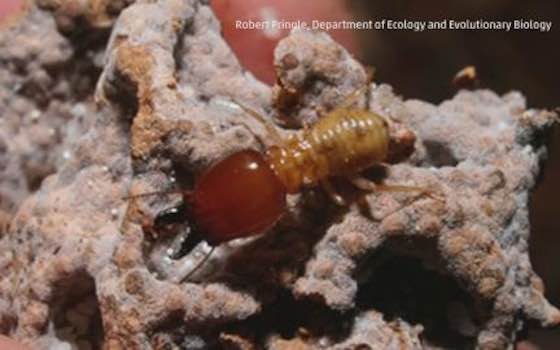- MENU
- HOME
- SEARCH
- WORLD
- MAIN
- AFRICA
- ASIA
- BALKANS
- EUROPE
- LATIN AMERICA
- MIDDLE EAST
- United Kingdom
- United States
- Argentina
- Australia
- Austria
- Benelux
- Brazil
- Canada
- China
- France
- Germany
- Greece
- Hungary
- India
- Indonesia
- Ireland
- Israel
- Italy
- Japan
- Korea
- Mexico
- New Zealand
- Pakistan
- Philippines
- Poland
- Russia
- South Africa
- Spain
- Taiwan
- Turkey
- USA
- BUSINESS
- WEALTH
- STOCKS
- TECH
- HEALTH
- LIFESTYLE
- ENTERTAINMENT
- SPORTS
- RSS
- iHaveNet.com: Environment

Termites, as surprising as it may sound, can indeed play a role in mitigating climate change through their unique biological processes. Here's how termites contribute to climate change mitigation:
Carbon Sequestration
Termites are known for their ability to break down plant material, including wood and dead plant debris, through digestion. During this process, termites release carbon dioxide (CO2), but they also contribute to carbon sequestration. When termites build their mounds or nests, they mix organic matter with soil, creating a stable carbon sink. The carbon is stored in the soil, removing it from the atmosphere and offsetting CO2 emissions.
Soil Fertility
Termites enhance soil fertility through their activities. As they tunnel through the ground, they improve soil structure, increase water infiltration, and facilitate nutrient cycling. Healthy soil promotes plant growth and productivity, which can enhance carbon uptake by vegetation and contribute to carbon sequestration.
Methane Consumption
Certain termite species have unique gut microbes that enable them to break down cellulose, a complex plant material. As a byproduct of this process, these termites produce methane. However, some studies suggest that termites can also consume methane, acting as a natural methane sink and reducing its release into the atmosphere. This can help mitigate the greenhouse gas effect of methane, which is a potent contributor to climate change.
While termites contribute positively to climate change mitigation through carbon sequestration and methane consumption, it's important to note that the overall impact is relatively small compared to other factors influencing the climate system. However, understanding the ecological role of termites and their potential benefits can inform conservation efforts and land management practices that promote healthy ecosystems and sustainable carbon management.
It's worth mentioning that the contribution of termites to climate change mitigation should be considered in the broader context of implementing comprehensive strategies that target significant sources of greenhouse gas emissions, such as reducing fossil fuel consumption, preserving forests, and promoting sustainable land use practices.
More Environment & Climate Change ...
- 5 Radical Takeaways from the Pope's Letter on Climate
- A Green-Energy Founding Father
- We're All Taking Dirty Pictures
- Faking It While the World Burns
- This Oil Spill Hits Close to Home
- A Fossil-Fueled Fantasy
- The Pentagon Makes War on Alaska's Pristine Wilderness
- Climate Denial Syndrome Sweeps Wisconsin
- How Climate Change and Resource Scarcity Are Upending World Politics
- Virginia Is for Dirty-Energy Lovers
- Humanity's War on Wildlife
- Making Green Cool Again in Hungary
- David and Goliath in the Amazon
- NASA Warns of 'Megadroughts'
- Our Growing Carbon Emissions
- Global Warming Triggered Syria War
- Round-the-World Solar Flight Takes Off
- 10 Extreme Weather Facts
- New York City Sea Level Rises
- Alaskan Glaciers Disappearing
- Leather Sludge New Bio-Fuel Source
- Why the Ocean is Turning More Acidic
- Why Whales Beach Themselves
- Termites Fight Climate Change
- Gas-Guzzlers On Road To Extinction
- Technology & Transformation
- Ecuador: All You Need Is Love and Oil?
- China Pulls Critical Pollution Documentary Offline
- Forging Our Future
- Green Believers
- The Glaciers Are Talking to Us
- Bald Eagles Nesting In New York City For First Time In 100 Years
- Asian Pollution Messing With U.S. Weather
- Instagram Account Shows Reality of Climate Change
- Keystone Pipeline Would Emit Tons of Greenhouse Gases
- Why You Can't Throw Away Batteries
- Road Salt Is Worse Than You Think
- Arctic Not Cold Enough for Polar Bears
- Doomsday Clock & Climate Change
- Sea-Level Accelerating Faster Than Previously Thought
- 6 Countries Dictate Planet's Future
- Manhattan Size Glacier Breaks Apart
- Opinions Split on Fracking Benefits
- Bad News for Sea Level Rise
- 2014 Hottest Year On Record According To NASA
- While Our Planet Melts, GOP Pleads Ignorance
- The Myth of the Wild
- Plastic Bags are Not a Need - Just a Bad Habit
- Environmental Security: Conflict or Cooperation?
- Beyond The Water-Food-Energy-Climate Nexus
- Climate Change Report Sounds Alarm for Planet Earth
- Genesis, Mother Nature and Environmental Stewardship
- Global Climate Change: Calling All Pagans
- Chicken Little 'Science'
- Climate Change and Interstate Conflict
- Fracking: A Deadly Power Surge
- Inhospitable Earth -- Compared to What?
More Environment & Climate Change ...
"Termites Fight Climate Change "